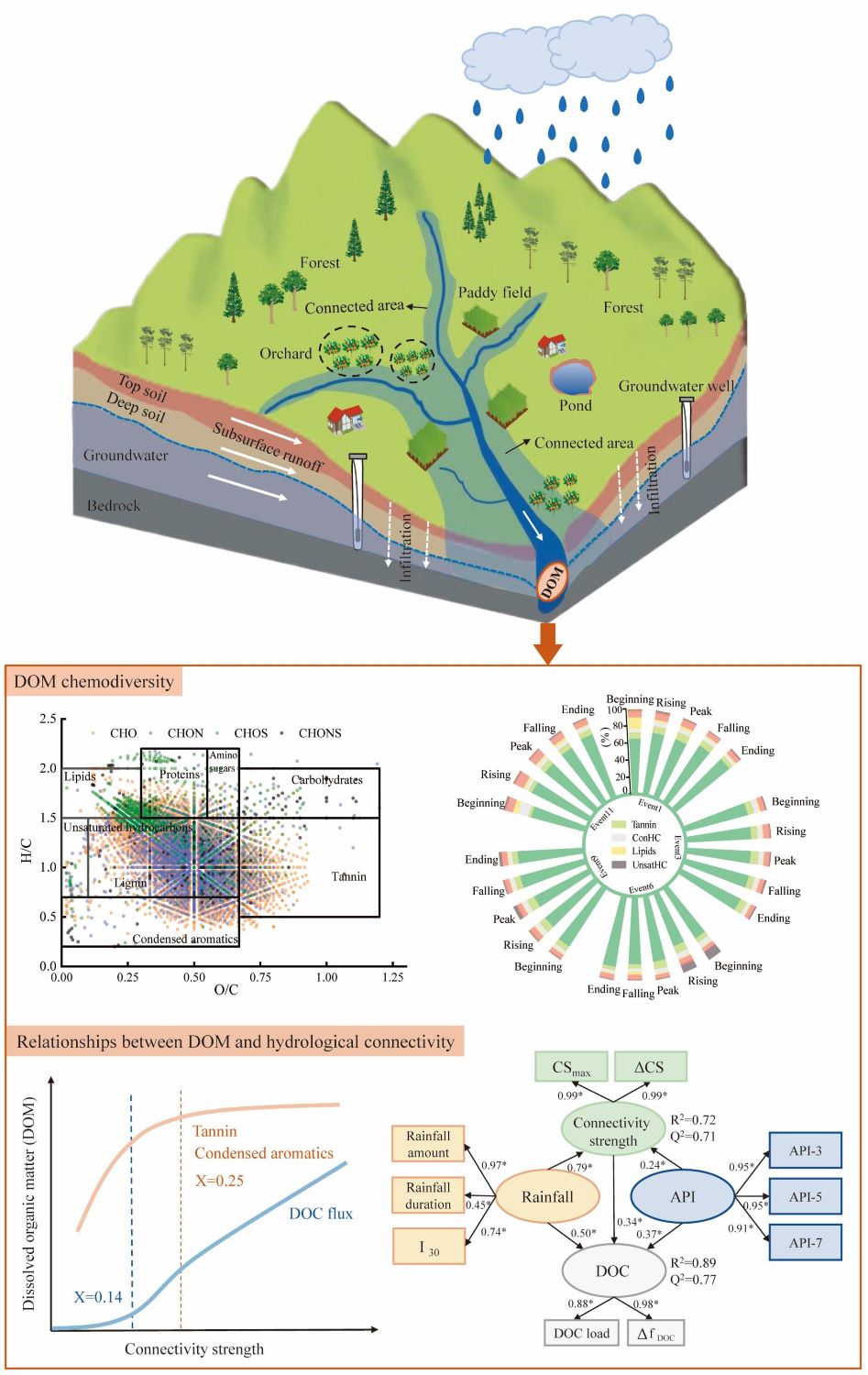南湖新闻网讯(通讯员 扈晓碟) 近日,我校水土流失过程与生态调控团队在流域可溶性有机质输出的水文调控机制方面取得进展,并在Water Research发表了题为Chemodiversity of dissolved organic matter exports from subtropical humid catchment driven by hydrological connectivity的学术论文。
可溶性有机质是水生生态系统中最大的活性碳库之一,对全球碳循环、水环境质量和水生食物网具有重要影响。径流是可溶性有机质迁移的载体,可溶性有机质能否随径流迁移至受纳水体主要取决于径流的畅通程度,即水文连通性,而根据径流路径的不同,水文连通性分为地表和地下水文连通性。降雨过程中,地表和地下水文连通区域的延伸与收缩,改变了可溶性有机质的来源和迁移路径,致使流域可溶性有机质输出通量与组分呈现出复杂的动态变化。因此,综合考虑地表和地下水文过程,建立流域水文连通性的综合表征方法,有助于科学理解流域可溶性有机质的输出过程。
研究团队通过对流域地下水位和出口径流进行长达20个月的连续监测,明确了降雨过程流域水文连通性的时空变化特征;高频采集了398个径流样品,借助高分辨率傅里叶变换离子回旋共振质谱法,揭示了流域可溶性有机质组分、分子特征和输出模式随降雨径流的变化规律,并量化了水文连通性与可溶性有机质化学多样性及通量的非线性关系。结果表明:降雨过程流域超过一半的区域无法与溪流建立水文连通,其最大连通区域主要受控于降雨量和降雨强度。流域输出的可溶性有机质组分以木质素为主,芳香性指数和等效双键数在流量峰值期达到最大。此外,流域水文连通性与可溶性有机质输出通量存在明显的阈值关系,当水文连通强度超过0.14时,可溶性有机碳输出通量快速增加;而当水文连通强度超过0.25时,可溶性有机质组分单宁和缩合芳烃的输出达到稳定状态。成果有助于科学认知流域可溶性有机质输出的水文调控机制。

流域水文连通性对可溶性有机质输出的影响
我校博士研究生扈晓碟为论文的第一作者,肖海兵副教授和史志华教授为论文通讯作者。我校硕士生邓雅文、硕士生周晨、王剑副教授、王真教授、赵劲松副教授、黄琬雲博士后参与了研究。本研究得到国家自然科学基金项目的资助。
【英文摘要】
The quantity and quality of dissolved organic matter (DOM) exported from source areas are closely related to hydrological linkage between source areas and streams, that is hydrological connectivity. However, understanding of how hydrological connectivity regulates the export of catchment DOM components remains inadequate. In this study, high-frequency monitoring of groundwater and runoff from subtropical humid catchment was conducted for 20 months, and hydrological connectivity was quantitatively characterized by considering both surface and subsurface hydrological processes. Fourier transform ion cyclotron resonance mass spectrometry (FT-ICR MS) was utilized to investigate the DOM molecular composition. Results showed that over half of the areas in the catchment could not persistently establish hydrological connectivity with the stream during the rainfall. The average proportion of lignin was the highest in DOM components, followed by tannin and proteins. Additionally, both modified aromaticity index and double bond equivalence reached maximums at peak discharge, reflecting terrestrial materials could increase DOM aromaticity and unsaturated degree. Partial least square-structural equation modeling revealed significantly direct effects of rainfall, antecedent conditions, and hydrological connectivity on dissolved organic carbon (DOC) export. Furthermore, nonlinear relationships were observed between hydrological connectivity and DOC, tannin, and condensed aromatics. Specifically, the instantaneous DOC flux increased dramatically when the hydrological connectivity strength exceeded 0.14; tannin and condensed aromatics exhibited a rapid increase with rising connectivity strength, but remained stable at connectivity strength above 0.25. However, hydrological connectivity showed no significant correlation with unstable components (such as lipids, protein, amino sugars, and carbohydrates). These results provide new insights into hydrological controls on the quantity and quality of DOM export and contribute to developing appropriate catchment management strategies for carbon storage.
原文链接:https://doi.org/10.1016/j.watres.2024.121902
审核人:史志华